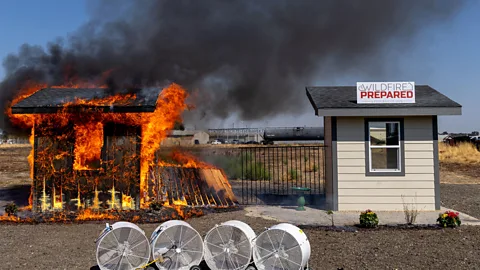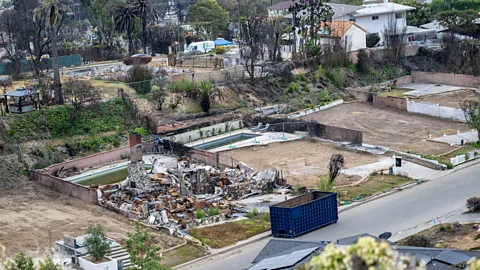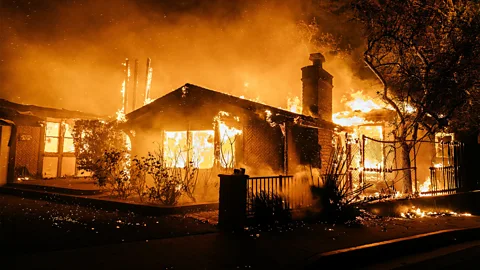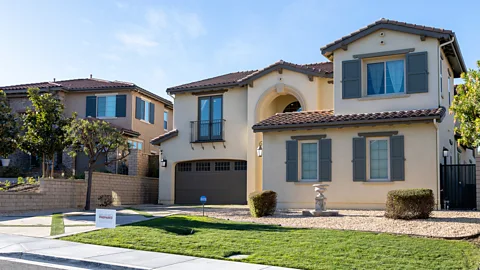'It's insane to build the same thing and expect different results': Can LA fire-proof itself?
 IBHS
IBHSSix months after the wildfires tore through Los Angeles, residents are tussling with the urban destruction left behind – and a debate over the future of the city's buildings.
Countless Los Angeles streets still contain the charred remains of homes that succumbed to wildfire six months ago. Many of their inhabitants are still living with friends and relatives or in hotels, hostels and shelters.
With more than 16,000 homes and buildings destroyed in the January 2025 wildfires, the LA neighbourhoods and nearby communities affected have been left contemplating how best to balance the need to get their homes back as soon as possible with future resilience to wildfire.
Today, even as the city faces the new turmoil of immigration raids ordered by President Donald Trump and the extensive protests that have followed, LA is clearing debris and preparing to rebuild.
LA wIldfires
In January 2025, a series of devastating wildfires tore through Los Angeles, leaving a wake of urban destruction. The Eaton and Palisades fires, the second and third most destructive in California's history, caused at least 30 deaths, forced more than 200,000 people to evacuate and destroyed more than 16,000 structures.
Progress so far has been slow, however, with few permits issued to rebuild (in Palisades, for example, just 125 rebuild permits have been issued out of 558 applications, the LA Department of Building and Safety told the BBC). Many residents have moved to communities far from the homes they lost, according to an investigation by the New York Times.
Faced with a daunting rebuild, many contractors and homeowners want to build quickly, with some working to loosen environmental protection code and permit requirements. Meanwhile, wildfire experts tell the BBC they want to ensure new construction is compliant with fire and energy codes, while sustainability advocates say they hope greener methods and materials will enter the market.
"There are going to be hard decisions on how we want to rebuild versus what is technically required," says Ian Giammanco, managing director for standards and data analytics at the Insurance Institute for Business and Home Safety (IBHS), a South-Carolina-based research group funded by the insurance industry.
California's building code was updated in 2008 to establish standards for wildfire-resistant construction. It requires the use of non-combustible materials and for homeowners to maintain defensible space around the home, such as by creating a safety buffer cleared of vegetation or debris. California is one of only five US states to apply a specific building code to areas designated as having very high wildfire risk.
 Getty Images
Getty ImagesHomes which had been constructed after 2008 in the LA neighbourhood of Pacific Palisades, which lost 6,837 structures in the Palisades Fire, were built with these requirements in place. But in Altadena, an area north of downtown LA where many neighbourhoods were affected by the Eaton Fire, many homes did not fall under the fire code.
In March, the California Department of Forestry and Fire Protection, a state agency often referred to as Cal Fire, expanded its maps of areas required to use the code, with existing homes at a minimum creating defensible space by clearing brush. The expansion means about 500 additional homes affected by the Eaton Fire will be covered by the code by late July 2025, according to analysis by US broadcaster NPR, but still leaves about 7,800 structures outside the high-risk zone.
Some of the proposed methods are already being used in the wider US. In Colorado, for example, where a 2021 wildfire destroyed nearly 1,000 homes in the Denver suburb of Superior, some homeowners have opted to rebuild using compressed earth blocks that have a high resilience to fire.
And CalEarth, a California-based nonprofit that pioneered a type of earthbag construction called super adobe, has drawn renewed attention from residents, says Khalili, and is urging state and local officials to work with them on making their designs code-compliant.
"Let's do the full tests… and build back prepared for these climate events," Dastan Khalili, president of CalEarth, tells the BBC. "It's insane to build the same thing and expect different results."
But bringing alternative building methods to market is costly, especially in California, where materials must prove to be fire-resistant while also passing stringent seismic testing.
Any alternative material, such as rammed earth – a building technique using compacted soil mixed with water and stabilisers which has been used for over 1,000 years, including, in recent decades, in California – must be submitted for testing, typically by manufacturers, says Crystal Sujeski, chief of code development and analysis for CalFire. This testing needs to prove they are equivalent to or exceed the standard set by conventional, widely used materials. "A lot of [testing] options are out there," she says.
New building materials that pass multiple tests can also be added to a register of approved materials, she says.
 Alamy
AlamyKhalili says CalEarth has always designed structures to comply with international building codes and has planned tests to meet the fire and seismic requirements of California's code. "All of that is ready to be executed," he says. "The only thing that's stopping us is the funding to go after it and make it happen." Burn tests in a fire lab for a single new material, he says, run at around $40-50k (£30-37k), and the required seismic testing can triple or quadruple this bill.
As a result, rammed earth homes and other alternative structures can be costlier than using more conventional methods – and even then, the process of approving construction at the state and municipal levels is arduous.
Ann Edminster, a green building consultant and author based in northern California, says that the ease and cost of the permitting process is highly dependent on the jurisdiction and who you work with. "The building official will either be your best friend or your worst enemy," she says.
It creates a wall of inertia boxing out those with interest in experimenting with alternative materials, she says. And in any case, if you have just lost your home to fire and don't have a place to live, "you're probably not going to be super enthusiastic about testing some brand new material", she says.
Still, there are relatively straightforward options for fire-proofing new builds – especially considering the risks of not doing so. A 2022 report by IBHS and Headwaters Economics, a Montana-based research institute, found that wildfire-resistant construction adds from 2% to 13% to the cost of a new home in California, with the upper cost here going well above current required codes. "Increasing home loss and growing risks require reevaluating the wildfire crisis as a home-ignition problem and not a wildland fire problem," the report said, noting that a home's building materials, design and nearby landscaping all influence its survival.
Stephen Quarles, an advisor emeritus at the University of California who has spent decades researching how building materials perform during wildfires, says it's more straightforward to obtain approval for smaller alternative projects.
Quarles emphasises that wildfire building codes are flexible and allow for traditional construction to be adapted and use more sustainable materials. For instance, a homeowner constructing a straw bale home can coat the exterior with a fireproof material to get approval from a code official.
"You could say, 'My cladding is stucco, which is non-combustible,' and you would be good to go," he says.
But he also acknowledges that most homeowners just want to rebuild as quickly as possible.
When the June 2007 Angora fire destroyed 280 homes in neighbourhoods around Northern California's Lake Tahoe, some residents raced to rebuild before the stricter code regulations took effect the following January, Quarles recalls. Later that same year, after the Tubbs fire ripped through the Coffey Park neighbourhood of Santa Rosa, the community "built back as if there [hadn't been] a wildfire there", he says.
But he believes the latest Los Angeles wildfires – along with the 2023 Lahaina fire on Hawaii's Maui island, which were called the "largest natural disaster in Hawaii state history" – have alerted people to the importance of hardening their homes in the future.
A January 2025 study found that the hot, dry weather that gave rise to the LA fires was made about 35% more likely by climate change. The LA wildfire season is getting longer, the study noted, while the rains that normally put out the blazes have reduced.
 IBHS
IBHS"There's an acknowledgement that these fires can happen in places where you don't expect fires to happen," Quarles says. "I think that's taking hold and there is a desire to genuinely build back better."
Giammanco, who contributed to a March 2025 report by IBHS documenting which types of homes survived the fire, agrees. "If you look back at our history of construction, there are inflection points," he says.
The report showed that homes compliant with California building codes had a higher survival rate than those which were not. But some homes that took preparatory steps, such as clearing brush and creating defensive space, still succumbed when enough of their neighbours had not taken these steps.
"Even the most hardened materials when subject to extreme fire exposure will reach their limit," Giammanco says. "Defending a community is sort of a system that builds on itself."
More like this:
• The people rebuilding their homes with earth
When wildfires spread in urban areas, the homes they ignite become "fuel bombs" and intensify the blaze, says Kimiko Barrett, lead wildfire research and policy analyst at non-profit research group Headwaters Economics. "The home itself is the fuel," she says. "Once your neighbour's house starts to burn, the radiant heat means that your home is threatened as well." This is a particular problem in LA, which despite its sprawling footprint is actually still a densely populated area, especially relative to more rural communities.
Slow progress in retrofitting existing homes remains a major problem, says Giammanco – and homes that predate California's 2008 wildfire code are not mandated to do it. But there is precedent for incentive and rebate programmes in the US to help make homes more resilient to extreme weather, from initiatives in arid south-western cities for residents to collect rainwater to an Alabama programme providing grants up to $10,000 (£7,400) to install roofing resilient to wind and rain. Giammanco says similar programmes for wildfire protection could incentivise residents to make their homes more resilient to fire. "I think that's the missing link," he says.
Adding fire-resistant materials in retrofits such as fibre cement siding and enclosing roof eaves to make it code compliant costs just a few thousand dollars, Barrett says. Other steps are even easier, such as clearing bark mulch from a home's defensive space.
"A lot of these mitigation measures can be done over the weekend by the homeowner," she says.
It's still early days in LA for the thousands of homeowners preparing to rebuild, but there are signs that the construction industry is starting to adapt. The LA-based homebuilder KB Home, for example, has designed a fire-resilient community with 64 homes that comply to IBHS standards.
 IBHS
IBHSWhen it comes to building new homes, Edminster emphasises that simple structures with minimal openings and overhang can be best, comparing an ideal fire-resistant home to an aerodynamic car. "The same principle could and should apply to homes," she says. "Obviously we don't want to live in little round spaceships or something, but… get your outer shell so that it works really well."
Sustainable building advocates are also pushing for greener materials and methods to become commonplace, arguing that they can be used in fire-hardened homes while also reducing emissions and bringing costs down in the longer term. For existing houses, simple retrofitting steps can improve the sustainability as well as the resilience of a home – even when they don't use the greenest materials possible. Some of Edminster's clients have retrofitted homes to be fire-resistant without stripping everything out. "That's a terrible waste of material and the embodied carbon in them," she says. "So there's a trade-off."
Edminster is adamant that building codes should stay in place after a disaster. "The whole idea of relaxing code to make it easier for people to rebuild, I think, is nonsense," she says. "[They] have been put in place to protect people and to protect us as a society."
And while many of the structures lost in the Eaton fire remain outside the boundaries of California's wildfire code, Barrett believes there is precedent for drastic change. US cities began mandating fire hydrants and sprinkler systems around the turn of the 20th Century after major urban fires in Chicago and San Francisco. Earthquake codes became stiffer in the 1970s, requiring buildings to retrofit for seismic risk reduction
"We can do this. We have done it before," Barrett says. "We just need to now think of it through a wildfire lens."
--
For essential climate news and hopeful developments to your inbox, sign up to the Future Earth newsletter, while The Essential List delivers a handpicked selection of features and insights twice a week.
